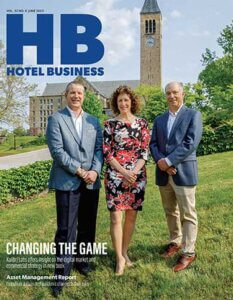There is certainly a renewed emphasis on outdoor experiences. With more focus on sustainability and an increased awareness for both physical and mental health post-pandemic, hoteliers and designers are honoring the environment now more than ever.
VITA, a boutique planning and landscape architecture studio, specializes in responsibly merging built environments with natural sites. The studio works with developers, architects and operators globally to create collaborative, synergistic environments.
Liliane Stacishin Moura, head of business development, VITA, offered an inside look into her role with the company, and what the future of hospitality landscape design may look like—a marriage of both passion and innovation.
“Each of our projects must be exceptional in its own merit,” Moura shared. “As place-makers, it is all about the place, the land and enhancing the existing landforms, and that is where our team excels. We take the time to understand what the land is offering us, including all its attributes. We believe the key is in feeling the place and sensing it, and finding the vibe that makes us want to come back to it. As stewards of the land, our job is to respect it. So balancing expectations while respecting the land is always a top priority for us.”
Since the pandemic, Moura explained, there has been a high demand from guests seeking unique, experiential destinations with wellness and outdoor activity programs.
“Many of our projects are luxury resort destinations and our assignment is to provide opportunities for guests to connect with the land and experience what the local environment, culture and history has to offer,” she said. “Therefore, there seems to be a greater focus from developers and operators on the outdoor activities, and we are fundamentally involved in developing these programs and designing the various amenities to support them.”
While creating fun, engaging environments for hotel guests is top of mind, this isn’t without sacrificing sustainability. In fact, sustainability serves as the foundation for Moura and her work.
“As landscape architects and land planners, sustainability principles are incorporated during our professional training and studies and is foundational to how we approach any project,” she said. “Our team is naturally looking for opportunities to implement technologies and ideas that are in harmony with nature and facilitates sustainable practices.”
Some of VITA’s recent projects include Camp Sarika by Amangiri in Southern Utah, a tented retreat amid a 600-acre landscape of towering mesas, slot canyons and rust-colored sands.
“Camp Sarika promises an intimate, back-to-the-wild experience in the desert heart of Utah,” Moura said.
“The camp’s cluster of 10 canvas-topped pavilions, each with a private plunge pool, centers on a shared lounge, restaurant and pool area—an enclave of meditative seclusion in one of the most geologically dramatic places on Earth.”
VITA served as the master planner and landscape architect on the Camp Sarika project.
“A unique aspect of this project was the site planning required to accommodate the variable conditions of extreme temperature ranges, wind, snow and sun, taking the structures and program and seamlessly blending them within the existing landscape in a way that enhanced the natural resources of the property and left very little impact on the land,” she explained.
Another project near and dear to Moura’s heart was a Brazilian private resort community.
“We are currently master planning a private resort community with an 18-hole Fazio Design golf course, residences, clubhouse, hotel, a church and various outdoor amenities,” she said. “As a Brazilian, I know how exceptional this project is and the potential it has to set a new market standard. In this project, my main role was to be the cultural translator and work very closely with the client and our design team.”
Because VITA focuses on luxury resort destinations, the team works in remote locations. Oftentimes, this means development is challenging and costly. However, Moura explained that because the segment is so hot right now, there’s ample funding available. She’s particularly excited about the studio’s prospects in Europe, the Caribbean and Latin America.
“We can’t share specific details about projects, but in the next months we have several exciting resorts opening in Kona, HI; Cabo del Sol in Los Cabos, Mexico; and Kiawah River in South Carolina,” she said.
“These three projects couldn’t be more different one from the other, so they truly showcase our teams’ creative talents.”
Designing with both sensitivity and authenticity in mind, while seamlessly integrating with the location’s architecture is key for Moura. VITA’s designs, she pointed out, draw inspiration from a site’s cultural context and natural setting, creating environments that express a distinctive sense of place.
“Integral to this is a stewardship of the natural environment and the desire to create elements which connect with the landscape and culture, transcending current trends of hospitality, real estate and development,” she said. “Great design tells a story and connects people with places. Our passion lies in helping to tell the story by striking a careful balance between the built environment and the natural setting.”


